Table of contents
If you’ve ever missed an important message among dozens of unread emails or received a notification that your email space is starting to run out, it’s clear that it’s time to develop new habits. Fortunately, you don’t have to do it by trial and error. There’s a method of mailbox management that will allow you to take control of your emails and is already utilised by millions of Gmail users worldwide. Get to know Inbox Zero.
What is Inbox Zero?
Inbox Zero is a productivity-promoting technique used by power users of many popular mail services. The idea behind this method is always to keep your mailbox empty, even when there are loads of incoming emails each day. Introducing a few simple habits to your daily routine will save you a lot of time and make your morning email review a source of satisfaction rather than frustration.
Inbox Zero in Gmail
Gmail allows you to achieve a blissful state of an empty inbox without installing additional plugins – by mastering the built-in features. During many years of developing the world’s most popular email service, Google has equipped it with many functions to support prioritising and sorting messages. However, not many users know about them.
Basics of the Inbox Zero method
Restore the original function to your inbox
Most users see a never-ending mix of new and old messages in their inboxes every day. When they remove one, another will jump into its place from the long list of emails hidden from view. That is not how Gmail was meant to be managed.
The primary mailbox folder should contain only new, unread messages that require you to take action (sorting, archiving or replying). Every morning, when you open Gmail for the first time, you ought to see only scheduled tasks and new elements that have changed since the day before.
Start strict prioritization
Of course, you cannot always respond to all senders immediately. From all the new messages in your inbox, select those that require action and move them to a visible place. An ideal place to store priority messages is an additional inbox, but more on that later.
Label less urgent messages to which you still plan to return. That way, they won’t go unnoticed when you start to deal with the matter they refer to. For example: label all invoices and messages from accounting as “Company” and archive them. When the time for reporting and settlements comes, you’ll find everything in one place.
All irrelevant messages you want to open in your free time should bypass the inbox and immediately go to the appropriate archive folder. We are talking about newsletters, mailings, and notifications. You don’t need to be distracted at the beginning of a productive day.
Delete email notifications that you certainly won’t open again. Gmail in Google Workspace has a large capacity (unlimited in the Enterprise editions). Although you probably don’t have to worry about running out of disk space, you could get distracted by messy search results – better to get insignificant emails out of the way.
Gmail settings
Gmail’s default settings work fine for most users on a beginner or intermediate level of proficiency with business tools. Five basic categories (Primary, Social, Promotions, Updates and Forums) create an automated message segregation system that works very well but utilises just a fraction of Gmail’s true potential. To take control of the tools available in Gmail, start by playing around with the settings.
1. Turn off categories
First of all, get rid of the default automated categorization in Gmail. Under the gear symbol in the upper right corner, you will find your mailbox’s Quick settings panel. Change the inbox type to Multiple inboxes and click Customise to open advanced inbox configuration options. But for now, switch the tab from Inbox to General to set additional symbols that will help you keep mail in order.
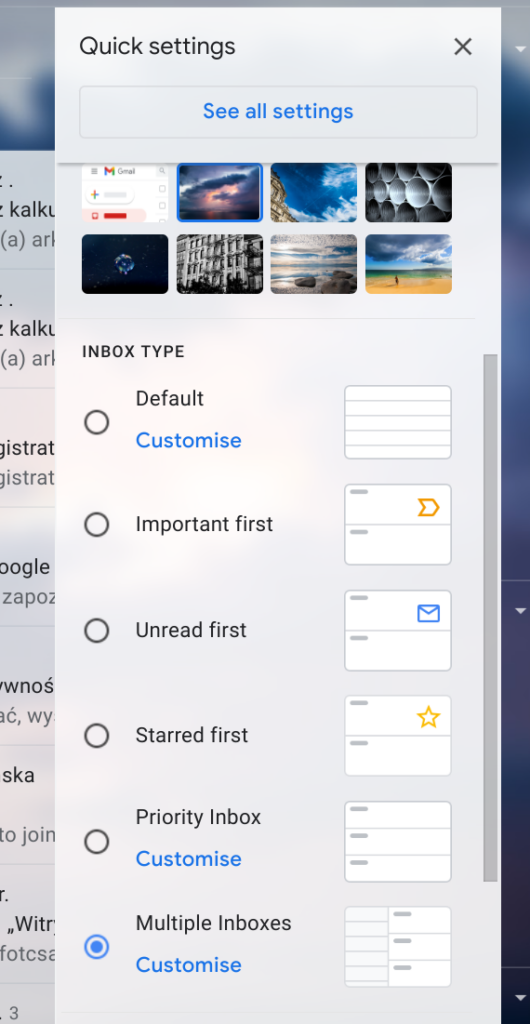
2. Follow the stars
Stars in Gmail are the most accessible and visible message marker. Although many people organize their priorities using labels, we suggest you test symbols as an even faster way of segregation.
One star is not enough to keep order, so go to the General tab in Settings to create more variants. Here you will find twelve symbols that will help distinguish priority messages. In the beginning, you probably need only four: yellow-star, green-check, red-bang and blue-info.

Marking an email with a symbol is simple: click the star next to a selected position on the message list – two clicks will change the default yellow star into a checkmark (✔️), three into an exclamation mark (❗), and four into the letter “i” on a blue background (ℹ️).
3. Even more mailboxes
In the Inbox* tab in settings, activate additional mailboxes and a view that will prioritize the most important emails. After you change the inbox type from the default to multiple inboxes, five lines will appear in which you can set the conditions for displaying messages in a given mailbox.
It’s time to use the symbols you just added. You can divide the inbox into three parts:
❗ To do – These are emails that require action (type in the search query is:starred has:red-bang. It will assure that only messages with an exclamation mark will go to this inbox)
✔️ Waiting – threads you have already dealt with and expect responses from senders (is:starred has:green-check)
[ℹ️] Current – threads that contain important information or files that you will be working on soon (is:starred has:blue-info)
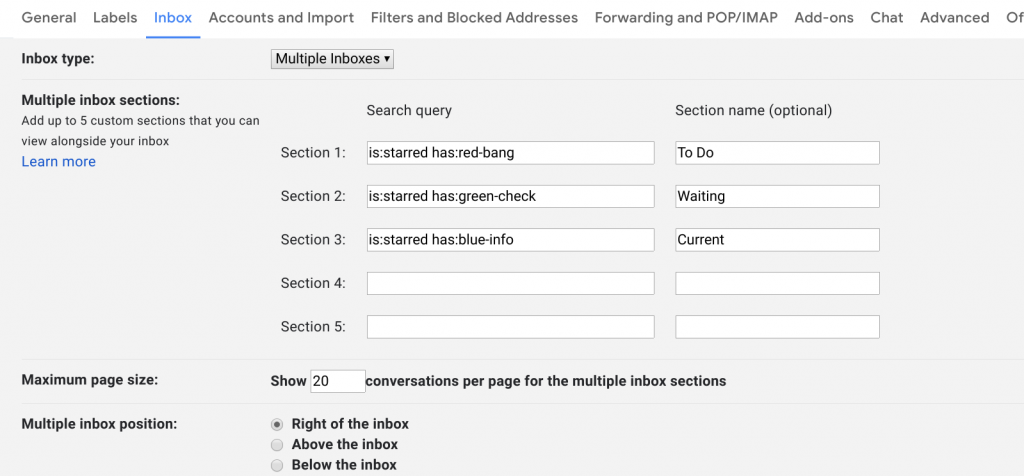
You can adjust these inboxes to your needs or add more of them. You can create an inbox for emails with a specific label (label:label-name) or messages from a particular person (from: [email protected]).
The next item on the list of settings allows you to change the location of additional inboxes.
*Note – if you can’t find the above options in your inbox, look in Advanced settings. Gmail is in the process of refreshing the interface, so the order of settings is different for some accounts.
Cleaning up the inbox
The time has come to dig through the pile of messages accumulated in your inbox. Relax, you don’t have to move each email manually. The first segregation that will set the whole rhythm of your future work with Gmail will take no more than half an hour.
Archiving, ignoring and deleting messages
Ignoring, archiving, and moving emails to the trash are actions that will allow you to get rid of all messages from your inbox.
Archiving sounds scary but should be the most used button in Gmail. Archived messages no longer appear in the inbox, but they do not disappear. You can still find them under the assigned label or by using the search bar. If they are not labelled, they end up in the unmarked message dump – in the All Mail folder. If a recipient responds to an archived conversation, the whole thread will appear again at the top of the inbox.
Ignoring allows you to get rid of intrusive messages without deleting them. It works similarly to archiving, but the difference is that new messages in ignored threads will not appear again in the inbox. This option is useful when a discussion in the thread distracts you or when you constantly receive unimportant messages from someone. You won’t see them again unless you intentionally search for the ignored email.
Deleting moves emails to the trash. This action is reversible for the next 30 days. A month after deleting, messages will permanently disappear from the disk.
Labels and filtering in Gmail
Labels and filters are Gmail-specific features that remain underestimated by many users. They allow you to organize all messages according to personalized criteria.
You can create a label in many ways: in settings, in the message view, in the side panel or when creating filters.
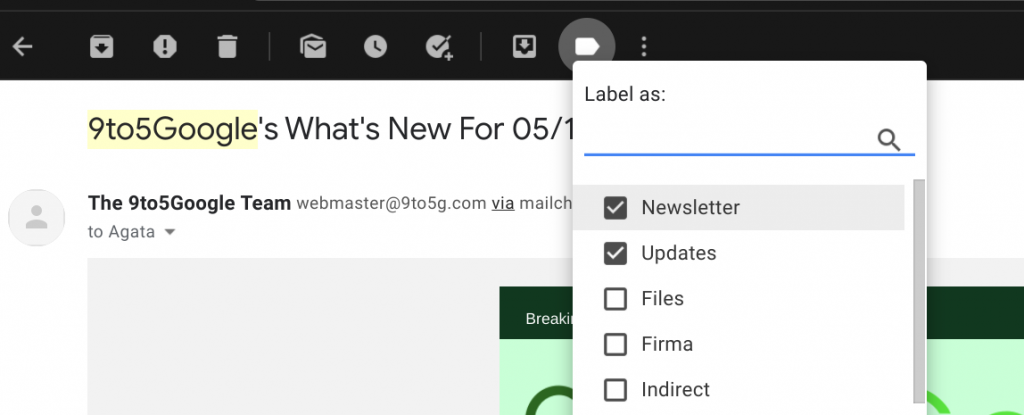
You can find folders with labels in the side panel on the left. Create as many as you need and assign them colours that will improve the transparency in your inboxes.

Labels combined with Gmail filtering allow you to fine-tune the automation of segregating 90% of messages in your inbox. There are plenty of recommended filter configuration options – but it’s so easy that you can improvise and experiment independently. Filters are set by selecting one or several emails and clicking Filter messages of this type in the drop-down list with the three dots symbol. Although the filters are not visible in the mailbox every day, you can make any changes to them by finding the filtering options in Settings.
Newsletters outside your inbox
Like any internet user, you have had the opportunity to leave your email address in a few marketing databases. Probably even in a few hundred. Thanks to GDPR, every promotional email now includes an unsubscribe link – and this is the easiest way to get rid of unwanted newsletters for good. However, you do not want to delete all of them. Some mass-mailed messages offer some value for the recipient, for example, in the form of exciting news or discounts. It is worth automating the sorting process to avoid moving each mailing, newsletter and offer individually.
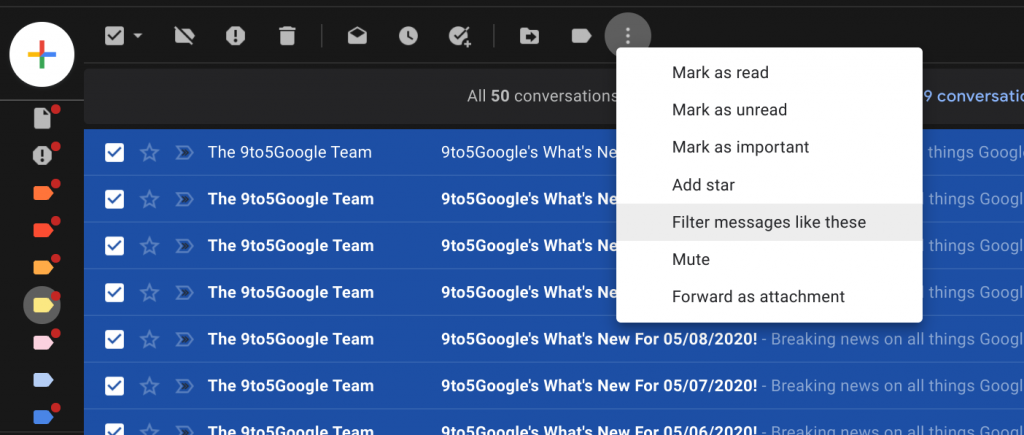
You can create several labels for different categories or senders of mass emails or choose a radical approach and throw them all into the folder with the Mailing label.
Regardless of what you choose, the procedure looks the same:
- Select the message and click Filter messages like these.
- A list of criteria will appear next to the search bar. Usually, only the sender’s address (or addresses) is enough.
- After setting the requirements, press Create filter
- Now you can choose what happens to messages that meet the criteria. To minimize distractions during daily mail review, select three actions from the list: Skip the inbox, Apply the label (in this case: Mailing) and Also apply filter to matching conversations.
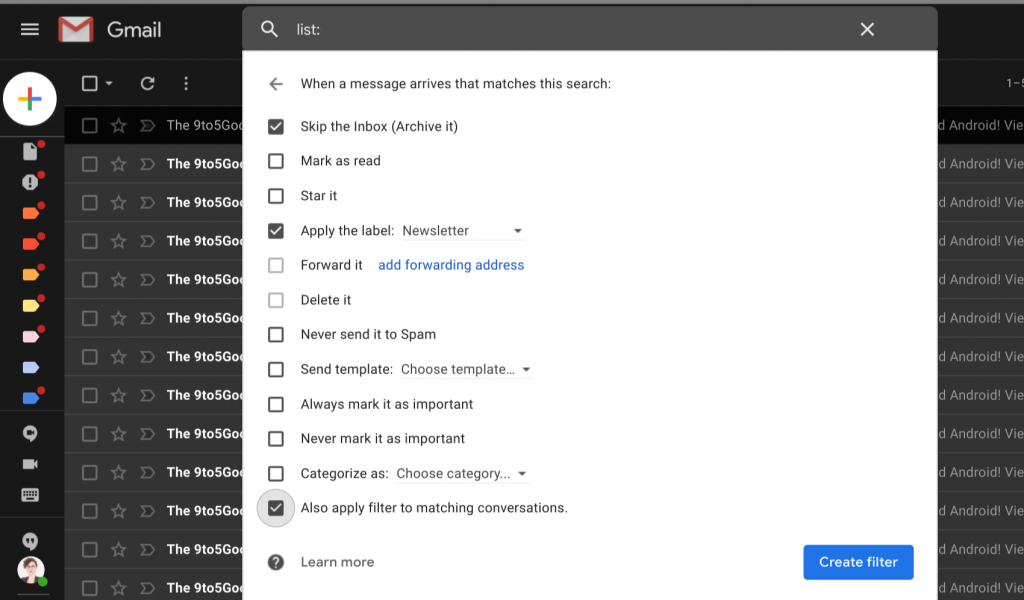
Such filtered messages will be automatically archived but can be found by clicking on the label. If you don’t have the correct label at hand, you can create one when you set the filter.
After configuring settings, deciding on priorities, entering labels and applying filters to incoming messages, your inbox should look like this:

A sequence of daily activities that will keep Inbox Zero forever
Cleaning is not everything. Now you need to maintain the order every day. To enjoy your empty inbox as often as possible, enter the following set of routines into your daily schedule:
- Read the most important emails first. If the response takes no more than a few minutes, do it right away. Otherwise, mark the message with an exclamation mark (❗) and archive it – after a few seconds, it will appear in the To do inbox.
- If you reply to a message and you now wait for the recipient to respond, mark it with a checkmark (✔️) and archive it – it will appear in the Waiting inbox.
- If the thread is interesting or important, but the discussion is over, mark it with a blue “i” [ℹ️].
- All other non-action emails should be labelled and then archived or deleted.
That’s it – a few minutes of clicking, and your inbox is empty again. You can now enjoy a productive workday, and unnecessary messages will not distract you from your priorities. Remember to look into the newsletter folder during your coffee break and browse the latest news from your favourite sites. sites.
It is just one of many possible Gmail configuration options that support maintaining Inbox Zero. If, through experiments, you discover other exciting solutions, then share them in a comment!
See also:
